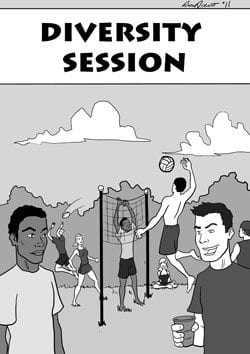
U.S. not yet post-racial
| “Let the old folks worry about race.” |
The election of Barack Obama as president created great optimism that America had entered a post-racial era. However, subsequent racially tinged political remarks have made it clear that such hopes were premature.
Racial views of many in the older generation have calcified over time. But there is hope that the younger generation will launch a new vision for race relations for the nation. A recent study by the Applied Research Center (ARC) entitled “Don’t Call Them ‘Post Racial’ — Millennials’ Attitudes on Race, Racism, and Key Systems in Our Society” indicates that the young are not yet free of the influence of race.
Those between the ages of 15 and 30 are characterized as members of the “Millennial Generation.” The ARC conducted a series of 16 focus groups in Los Angeles. Participants were 18-25 and were divided into four groups: whites, African Americans, Asian Americans/Pacific Islanders and Latinos. The conclusion was that even among the young, “race still matters.”
The responses to the research questions seem to be the respondents’ observations of the racial flaws that still exist in society. In a poll of 18-25 year-old whites in 2003, 89 percent had no objection to interracial dating. A similar survey in 1987-1988 to Generation Xers found only 58 percent were supportive. Social attitudes have certainly changed.
There was some commentary in each social group, regardless of race, that the problems stem more from differences in class than differences in race. From the respondents’ point of view, “it is essentially a historical accident and/or irrelevant that the upper class overwhelmingly consists of white people and that people of color are overrepresented in the ranks of the poor.”
The class issue also becomes significant when considering the impact of race on the criminal justice system. Some whites in the focus groups believe that the quality of justice is essentially a class issue. Those with the financial resources to engage the services of quality lawyers are able to buy better treatment in the courts.
Some whites indicated that good contacts are important for employment — again, a class issue. A black participant indicated that class determined the quality of medical care, how well a patient is treated. Another black complained that he was not well treated at work because of his dreadlocks — another class issue.
The focus groups found it difficult to define racism in the five areas under discussion: criminal justice, employment, education, housing and health care. Once participant spoke of “race fatigue” which often degenerates to the blame game.
Millennials have limited understanding of the long history of racism in America and they have little understanding as to how racial hostilities have become institutionalized. In the 2008 presidential election 66 percent of youths voted for Obama while only 32 percent voted for Sen. John McCain. This indicates that a strong rejection of racial discrimination among the young is already underway.
It is still the responsibility of the adults to correct those flaws in American society that discriminate unfairly against fellow citizens because of race.






